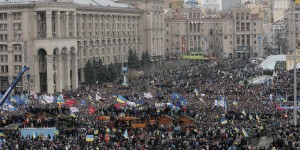As the newspapers are filled with images and stories of civic engagement, protests and demonstrations around the world and citizens trying to collectively achieve change within the national context of politics, I start wondering over the actual effects; the pragmatic achievements of these protests.
During the last few weeks there have been several cases of demonstrations, protests, clashes and uprisings in for example Turkey and Ukraine. Political reasons aside, as they differ substantially, these demonstrations are the result of an increased civic engagement as counter-reactions to political establishments and governmental attempts to control the public spheres of society. One of these spheres is constituted by digital technologies and social media in particular; tools for which activists can organize and mobilize the protests with pace and low budget in coordination efforts. Social movements are dependent on high numbers of participants in order to have effect (as in get attention and gain further support) and social media simplifies the path to reach this high number. And when protests become mass events, like the case of Ukraine and Turkey during the last days, as well as Egypt in 2011, pundits often refer to this as spectacular events through which days for regimes must be numbered.
However, as for example the case of Egypt hs shown, the long-term aim of the protests is seldom achieved as new forms of authoritarianism and repressive powers seem to take charge. Since the Arab spring of 2011, this retainment has taken place in several nations in the region. One important explanation for this is that before the Intrenet and digital mobilization, social movements had to take time to coordinate actions during a longer period of time, thinking about sustaining momentum after the initial phases of the protests (including infrastructure for decision making, political renewal strategies, long term policies etc.) These days, movements leap over this work, taking mobilization beyond these processes, all in the midst of excitement over possibilities for rapid change but without a solid preparation for the times to come. Occupy Wall Street is yet another example of this. Noble ideological agenda, rapid growth, excessive international support with minor fractions, but the result so far… well.. not correlated with the stated aim.
The Indignados in Spain 2011 (a group of protesters who labelled themselves this, meaning ”the outraged”) is another example. What happened in Gezi Park in Istanbul last year did however get wider attention and a more progressive outcome, however when reaching the local election, the ruling party is still set to remain in power.
This does not mean that I oppose to the civic engagement and use of social media to organize or mobilize. On the contrary, the fact that the Turkish Prime Minister Recep Tayyip Erdogan during the Gezi protests called Twitter and other social media a ”menace to society” bear witness of the need to actually use the available tools to challenge and to question the political establishments. But the last couple of years can actually enlighten and help future social movements and civic engagement to combine pragmatic political work and organization with rapid mobilization through digital technologies. In that way, the effect, outcome and pragmatic socio-political change may actually succeed and remain in a longer period of time than the days people were on the street chanting for freedom.




